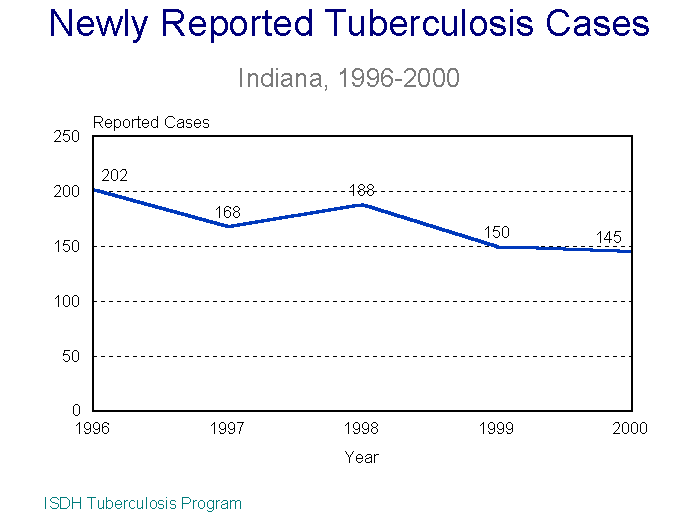Figure Tb1: Newly Reported Tuberculosis Cases, Indiana, 1996-2000

2000 Indiana Report of Infectious Diseases |
View ISDH's Quick Facts on Tuberculosis
View CDC's Tuberculosis FAQ page
Rates presented are per 100,000 population and are based on the U.S. 2000 Census.
| Cases | Incidence Rate |
|
| Total | 145 | 2.4 |
| Race- and Ethnicity-specific cases and rates | ||
| White, Non-Hispanic | 72 | 1.4 |
| Black, Non-Hispanic | 40 | 7.8 |
| Asian | 11 | *18.0 |
| Hispanic | 126 | 170.8 |
| Sex-specific cases and rates | ||
| Female | 51 | 1.7 |
| Male | 94 | 3.1 |
Tuberculosis (TB) is an airborne disease caused by Mycobacterium tuberculosis. During 2000, 145 new cases of tuberculosis were reported to the Indiana State Department of Health (ISDH). This represents a 3.3% decrease from the 150 cases reported in 1999. The state case rate was 2.4 cases per 100,000 population. TB was reported by 46 (50%) of the 92 counties. Generally, cases were associated with urban and suburban counties. Figure Tb1 shows new cases for 1996-2000.
Figure Tb2 shows the Indiana incidence rates by race and sex. In 2000, males represented 64.0% of the newly diagnosed TB cases. The incidence rate per 100,000 population was 3.1 for males and 1.7 for females.
In 2000, 23.4% (34/145) of cases were foreign-born (Figure Tb3). Among the foreign-born, Latin America and the Caribbean accounted for 44.1% (15/34) of the cases. These individuals came from Mexico (13), Honduras (1), and Jamaica (1). South, east, and southeast Asia accounted for 32.4% (11/34) of the foreign-born cases, with cases coming from Vietnam (2), the Philippines (2), Burma (1), Malaysia (1), and India (5). Africa represented 17.6% (6/34), with cases from Malawi (2), Zimbabwe (1), Kenya (1), and Ethiopia (2). The remaining 5.9% (2/34) came from Europe. Both of these cases were from Russia.
HIV infection is the most important risk factor for rapid progression of tuberculosis from infection to active disease. Figure Tb4 shows the numbers of TB patients co-infected with HIV.
Drug susceptibility testing should be performed on all positive TB cultures to detect any resistance to the medications prescribed. Of the 145 TB cases reported, 4.8% (7/145) were resistant to at least one anti-tuberculosis drug, usually isoniazid (INH). One case reported in 1999 developed INH resistance during 2000. Multi-drug resistant (MDR) TB is defined as resistance to both isoniazid and rifampin. MDR-TB is of particular public health concern, since these two drugs are the most effective medications used to treat TB. If the organism is resistant to them, less effective second-line drugs must be added, extending the treatment period to 18-24 months. There were no cases of MDR-TB in Indiana in 2000. Figure Tb5 shows the number of drug-resistant cases.
The most important priority in TB control and prevention efforts is to initiate treatment and ensure completion of therapy. The national objective is to have at least 90% of all patients complete an adequate and appropriate course of therapy within one year. Figure Tb6 shows the percentage of patients for whom therapy of one year or less was indicated and who completed treatment within one year. Exclusions from the rate calculations are those who (1) were dead at the time of diagnosis, (2) died before completing therapy, (3) never started therapy, and (4) had multi-drug resistant disease. This information is collected at the end of therapy, so the current data are for those patients who began therapy in 1999.
Figure Tb7 gives an overview of where the TB cases occurred within Indiana. The numbers represent the number of persons in each county who had an Indiana address at the time of diagnosis and who were verified as having TB disease in 2000. Persons counted in another state and immigrants and refugees who are diagnosed and begin treatment abroad are excluded. Foreign visitors diagnosed in Indiana but who will remain in the U.S. for less than 90 days of treatment are also excluded. The numbers of drug-resistant cases are in the dark circle.
Back to Top of Article
Back to Table of Contents
|
Figure Tb1: Newly Reported Tuberculosis Cases, Indiana, 1996-2000 |
|
|
Back to Reference in Text
Back to Top of Article
|
Figure Tb2: Tuberculosis Cases by Race and Sex, Indiana, 2000 |
|
|
Back to Reference in Text
Back to Top of Article
|
Figure Tb3: Tuberculosis Cases, US and Foreign Born, Indiana, 1996-2000 |
|
|
Back to Reference in Text
Back to Top of Article
|
Figure Tb4: Tuberculosis and HIV Co-infection, Indiana,1996-2000 |
|
|
Back to Reference in Text
Back to Top of Article
|
Figure Tb5: Tuberculosis Cases with Drug Resistance, Indiana, 1996-2000 |
|
|
Back to Reference in Text
Back to Top of Article
|
Figure Tb6: Completion of Tuberculosis Therapy, Indiana, 1995-2000 |
|
|
Back to Reference in Text
Back to Top of Article
|
Figure Tb7: Tuberculosis Cases by County, Counties with 5 or More Cases, Indiana, 2000 |
|
|
Back to Reference in Text
Back to Top of Article
* - Rate based on less than 20 cases and should be considered unstable.
Back to Table of Contents
[an error occurred while processing this directive]